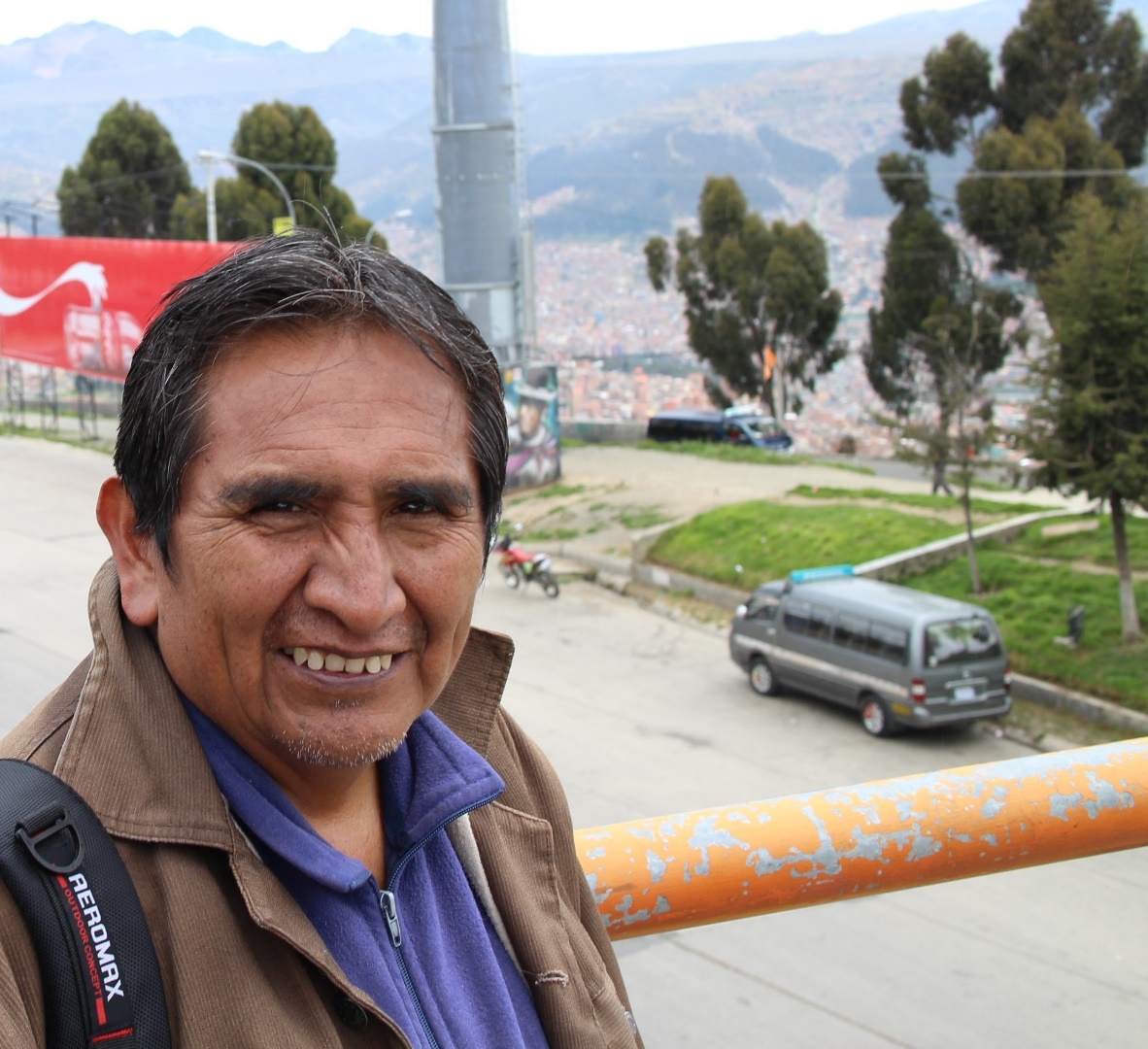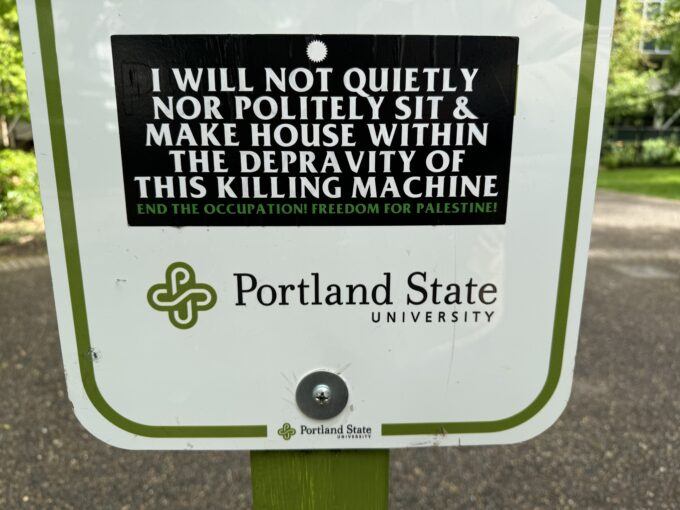The Politics of Everyday Life in El Alto, Bolivia’s Aymara City
Aymara journalist Julio Mamani talks about the politics, rebellions, and future of El Alto, Bolivia’s Aymara city.
August 23, 2024

Aymara journalist Julio Mamani in El Alto, Bolivia. Photo by Ben Dangl.
In this interview, Mamani talks about this this type of journalism, how the city has changed over the past twenty years since its pivotal role in the uprisings against neoliberalism at the turn of this century. He examines the politics of the city’s neighborhood councils which govern the city’s urban communities at the micro level, and how corporate globalization and politics are changing the social fabric of the Aymara city.
Aymara journalist Julio Mamani and I meet at one of the new aerial cable car stations in El Alto, Bolivia. A cool Andean wind is blowing through the nearby street market as the cable cars hover above our park bench. We have known each other since the early days of the Gas War in Bolivia in 2003, when popular movements ousted a repressive government. Those uprisings in the streets ultimately led to the 2005 election of Bolivian President Evo Morales of the Movement Toward Socialism (MAS) party and ushered in a new era in the country’s politics.
Since then, Mamani has continued his work as a journalist, focusing on the everyday lives of this city in the clouds, nestled in high plains at over 13,000 feet. The majority of El Alto’s residents are Aymara Indigenous people, and the city is well known for its massive open air street markets.
Mamani’s journalistic work now emphasizes “the everyday life of alteños, because that’s not talked about. Nobody sees what’s happening down here, what’s going on,” he says, gesturing to the nearby market stalls. “We are in this reality doing a journalistic work.”
In this interview, Mamani talks about this this type of journalism, how the city has changed over the past twenty years since its pivotal role in the uprisings against neoliberalism at the turn of this century. He examines the politics of the city’s neighborhood councils which govern the city’s urban communities at the micro level, and how corporate globalization and politics are changing the social fabric of the Aymara city.
Benjamin Dangl: How do you get into this everyday life to show this other life in El Alto?
Julio Mamani: For example, the coronavirus pandemic taught me that in a way. People were looking for sustenance, they were locked in a quarantine. Generally, people defied the virus to be able to sell at the fairs with their carts, that’s how they managed to survive, by risking their lives every day.
And every day, there were initiatives by people who live off informal trade, and they are discriminated against, especially the peddlers or traveling vendors who don’t have a fixed stand, so they travel through the fairs with their carts. These are all initiatives they have to survive, the way they buy their products from wholesalers, for example, fruits and vegetables, and they take them to the fair, so they have their own income.
Imagine, during the pandemic there was no transport, people had to travel on foot. We’re there, in that reality and in their needs, which are, for example, improving their areas, transport price hikes, and how they manage to buy their tickets.
El Alto street markets are a world in their own, it’s not only the 16 de Julio [market], everyday there are markets where some are selling, others are buying, there is a microeconomy, and alteños have these initiatives outside the political life of leaders, who are a bit disconnected from this. This is the daily life I’m interested in looking at right now.
BD: You’ve worked so many years in El Alto as a journalist, can you give me an example of how the city has changed?
JM: It changed quite a bit. Right now there’s a cable car that gives it a modern look. But also the problem of social media, right? It used to be a novelty to see the internet, now there are many. And you have it in your own phone, you can see the technological advance.
Some avenues have been improved, have been paved, there’s more mobility. El Alto keeps growing and it’s reaching its limits, as it’s been joined to Laja, Achocalla, Pucará, Viacha. It used to be a far away, an isolated area, there was a big distance between the borders of El Alto and Viacha, and now they’re together.
There are more people too, more students. During festivals and holidays you can also see this, more participation of young people.
You can also see the famous buildings of El Alto; a fundamental issue is the identity they’re acquiring. In a city where we could say the identity is Aymara, you can also see a bust of the Statue of Liberty on a building.
We see characters from TV series and social media, like the Transformers. Characters that begin to win spaces in the city. Not only Aymara, now it’s also figures coming from movies and social media, from the symbols of North America.
But one wonders, why do we have the Statue of Liberty on a building, right? But it’s a culture that’s already seen here as a result of globalization; our context doesn’t escape that.
Young people are always in this situation. Since 2010 up to now you’ll see nobody is without a cellphone, using Facebook and TikTok, and all the platforms of communication. So, we can see that El Alto is becoming globalized and breaking its isolation in terms of culture. The [Western] empire has already penetrated culturally.
So, El Alto people talked about the city as isolated, with a purely Aymara identity, now a different identity begins to emerge through globalization. You see it during Christmas too, with the imperial symbol that is Santa Claus. And now during Christmas you see the Grinch.
And in educational institutions characters have also changed, now you see the Avengers, the heroes of the northern empire. This is not a violent entry but a voluntary assimilation. That’s what I can say, in general terms, of what El Alto used to be and what it is now. As I said, young people predominate, and they seem to be globalized so they’re manifesting these identities. The ancestral seems to be relegated to older people. It’s a vertiginous change.
BD: When we first met in the early 2000s, the neighborhood councils in El Alto were very strong. How has that changed? Are these neighborhood groups still strong?
JM: It depends very much on the place. The problem of historical processes is that they’re dynamic, and this is manifested in a certain way. It manifested when the Aymara identity was strong, through a struggle that developed from neoliberal times, and the situation has been accumulating. And those powers manifested at certain times, but in the neighborhood councils the leader is a prisoner of his bases, for example, where there is more movement and dynamism is in the more remote areas [outside the center of the city], and they’re mobilized by social basic services.
I work in a water company, and I can see that every day, how neighbors are mobilized. There’s also an economic phenomenon. A plot of land without water is not valued as much as one that does have water. To give you an example, in a neighborhood recently created, a 250 m2 plot is worth $2,200-4,000 USD, when they connect water and sewage, it’s worth $15,000 USD. It’s a difference of $11,000 USD. If there are streets, even more. So that is mobilizing, in fact, those needs add a political and economic dynamism.
The leader in those neighborhoods both has power and doesn’t have power: if he obtains something, he’s welcome. If he doesn’t, there will be pressure and he can be removed. So, he has to make arrangements. The leader is in all that.
We shouldn’t forget that economic conditions, unemployment, means that leadership in El Alto is a job, a way of having an income, and that has impaired this type of organizing; if this happened in the past to a lesser degree, now it’s been increasing.
Now, in terms of bases and neighborhood leaders, we see a divorce. They’re more controlled by their bases, and the test would be to get basic services: water, sewage, gas and road improvement. This means to improve the quality of life and add value to the plots of land.
BD: Regarding El Alto’s rebellions against neoliberalism in the early 2000s, how do see the legacy of those rebellions and demands today?
JM: It’s been almost erased from history books. For us, if you seriously analyze social and historical events of the peoples, we’d say that it has been a fundamental milestone that after twenty years a neoliberal government is kicked out, after many deaths, and a process of change opens up. But almost in no texts is this mentioned. It doesn’t exist.
Bit by bit, the memory is being lost. The young ones have no memory of this. It has been twenty years. How old were the young ones back then? Some were not even born. That memory has been gradually erased. For a part of the political class it’s not convenient that this is remembered because they weren’t the protagonists nor makers of that episode. So, it’s not useful politically for their purpose.
BD: We’ve talked about changes in the last twenty years, how do you see the future of El Alto? What are we going to see as a city in the next twenty years?
JM: It’s already bigger than La Paz, it has more than one million inhabitants according to official data. And La Paz is around 900,000, and El Alto keeps growing fast. The demographic growth won’t be as sharp, though, as it can’t surpass the limits of the [neighboring] municipalities of Viacha, Laja and Pucará, so that’s how far it can go.
It will have to become a metropolis or something to deal with the issue of water and basic services, but especially water. El Alto doesn’t have enough wells; 30-40% of wells are within its jurisdiction, but the rest are in the provinces [outside the city]. In the case of dams, besides Milluni, which doesn’t supply El Alto, they are in other provinces, not in El Alto. So that tells you that it will have to coexist with the municipalities or it won’t be able to keep growing. There will be growth if there are services.
As for the youth, as we discussed before, taking into account some massive events like Halloween or carnivals, you see the problem of identity, and buildings that have drastically changed. The presence of characters from globalization indicate this will be a different generation, it will be more globalized, and it’s a phenomenon we won’t be able to escape. El Alto will be globalized, as you can already see in the cable car, that’s where we really are. The identity might keep being Aymara, but it will be combined and in coexistence with globalization. That’s what I see for the future.
Note: This interview was translated from Spanish to English by Nancy Piñeiro and has been edited for clarity and length.

